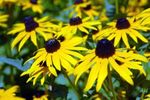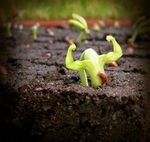Sow flower seeds now for plants acclimated to Ann Arbor's climate
Free plants?? Well almost. Winter sowing is one of the cheapest and most hassle-free ways to grow new plants.
You get some seeds, put them in a little clear container with some dirt and stick them outside. Yes, outside now, in the winter. Then you forget about them until the spring when they start coming up.
Here are the details:

Black-eyed Susans are good perennial plants for the garden.
Seed selection
Winter sowing works best with hardy native plants. In the Ann Arbor area, the plants I've had the best luck with are Black-Eyed Susan (Rudbeckia hirta), Purple Coneflower (Echinacea purpura), Prairie Blazing Star (Liatris pycnostacha), Wild Lupine (Lupinus perennis), and grasses like Little Blue Stem (Schizadyrium scoparius).
Native plants are especially good for this because they already have evolved to withstand and grow in the local conditions. By winter sowing, you're just giving them a little helping hand (with the mini-greenhouses) and increasing the ratio of seeds that survive. The BackyardGarder.com Web site and a comprehensive plant encylopedia that may help you choose your plants.
Planting medium
This is easy. Dirt. Just plain old dirt. I like to use fresh compost or the cheapest dirt I can find at a store. If you use dirt from outside just be aware that you may get some weeds or other plants, so you'll want to know what your seedlings look like at early ages so you don't accidentally weed out all the good seedlings. Just take a peek at Google Images for pictures of the seedlings you may be unfamiliar with.
Vessel preparation
I like to use old, clear plastic 2-liter pop or juice bottles. I've tried milk jugs, but didn't get great results from them. With an Exacto knife poke about 4 or 5 small holes for air around the top, then about 2 holes on the very bottom so that water won't collect too much. Then cut the bottle nearly in half, leaving a little hinge. It should go without saying the pop bottle should be well-rinsed and cleaned before use.
Planting
Fill the bottle about a third of the way with your dirt. Place your seeds in the dirt (2 times as deep as the seed is long is a good rule of thumb). I find it easier to do 1 plant type per bottle rather than mixing them up. Give the dirt a small splash of water (just so it isn't completely dry), then tape up the bottle along the cut so it stays closed. I've had good luck with regular masking tape. Then write the name of the seed in permanent marker in a few locations on the bottle (the bottle cap seems to keep the marker the best).

Spring harvest
As it gets warmer out in the spring, you'll start to see little sprouts form. Around the first week of May, I start to poke more holes in the top of the bottles. Then after about a week or 2, I take off the bottle caps. Then at about mid- to late-May, after the threat of frost is gone I untape the bottles. The hardest part of winter sowing is determining when the seedlings are ready to plant.
I tend to get excited and plant too early, so I usually wait longer than I think they'd be ready. But usually it's before June when you plant them. I just take some scisors and cut the bottle open so I can easily scoop out the dirt as a whole unit. Then you carefully divide them and plant them. Remember to water them a lot as they grow.
The first year
Some plants, like Purple Coneflower, won't flower until they're 2 years old. So, don't get too worried if your yearlings don't get too big or flower. They've got a lot of work to do putting down roots that first year. You'll find that some plants work better than others, so have fun and experiment.
Joe is a fifth generation native resident of Ann Arbor who has lived within a mile of the Michigan Stadium for over 30 years. He works in IT at the University of Michigan and is a PhD student at Eastern Michigan University's College of Technology. Woodworking, native plant gardening, snowshoeing and running are a few of Joe's hobbies. Joe can be reached at joebauer@gmail.com.


Comments
Monica Milla
Fri, Jan 15, 2010 : 3:51 p.m.
Hi Joe, I sow in milk jugs and lidded flats (I used to be an indoor sower), which I drill holes into, top and bottom. I'm the queen of cheap and have found the soil mix is worth its weight in gold! I'd like to invite you (and your readers) to the talk on Tuesday, Jan. 19, at 7:00 pm at the Extension Center at 705 N. Zeeb Rd. in Ann Arbor. It's free and you don't have to be a master gardener to attend (though it's put on through the Washtenaw MGs).
Joe Bauer
Wed, Jan 13, 2010 : 4:22 p.m.
Full Bloom - Thanks for sharing your classes and books with us. Do you use containers designed specifically for winter sowing? When you start digging around (pun intended) you can find a whole lot of information out there on winter sowing. As you mention, there are lots of types of planting mediums out there. I tend to go the cheapest route, which often means more weeding or a higher seed mortality rate. I've used everything from stuff I dug up in the yard in the fall to soil purchased at the local hardware store. If you really want to boost the survival rate of your seeds (decrease the mortality rate) then I would encourage readers to learn a lot more about winter sowing than the very short overview I give here.
Monica Milla
Thu, Jan 7, 2010 : 6:25 p.m.
I wanted to add, containers for winter sowing need top and bottom ventilation and the soil really needs to be a container/soil mix. Cheap topsoil will turn into a hard rock (in addition to being weedy as you mentioned), and seed starting mix is too light and fluffy for outdoor winter sowing.
Monica Milla
Thu, Jan 7, 2010 : 6:21 p.m.
I've been winter sowing for six years and frequently speak on the topic. I have a free talk coming up in Ann Arbor on Jan. 19 and I teach a lifelong learning class at Washtenaw Community College on Feb. 10. I also self-publish a book, Fun with Winter Seed Sowing, on the topic. All kinds of seeds can be winter-sown, including veggies! Feel free to contact me if you or your readers would like more info.
Julie Martin
Tue, Jan 5, 2010 : 10:23 p.m.
I did morning glories like this last year - worked great!
amazonwarrior
Tue, Jan 5, 2010 : 10:29 a.m.
What a great idea! I have passed on your article to a couple of friends who are avid gardeners. I'm really looking forward to trying this because I have seeds from new/friends' plants that I collected last year. Thanks Joe!
Joe Bauer
Mon, Jan 4, 2010 : 9:01 p.m.
Great! let us know how it goes :) If you don't have any seeds right now you may consider going to the Wild Ones seed cleaning event at the Botanical Gardens coming up on the 16th. If you're nice enough they might let you take a few home;-) From the Ann Arbor chapter of Wild Ones: http://www.for-wild.org/chapters/annarbor/ "Jan 13, 2010 (Wed) Time: 6:45 pm Location: Matthaei Botanical Gardens Room 125 1800 N. Dixboro Road Ann Arbor, MI 48105-9406 Title: Seed Cleaning Workshop & Exchange Description: Join the Wild Ones as learn about how to gather, process, store and sow seeds of the plants of our Michigan natural heritage - native plants - in our own back yards. Bring seeds to show and exchange, or just come with nimble hands. Past highlights of this workshop included cleaning milkweed seeds by touching a match to them and poof! Free and open to the public."
Barb
Mon, Jan 4, 2010 : 4:37 p.m.
Cool! I'm totally going to do this. :)